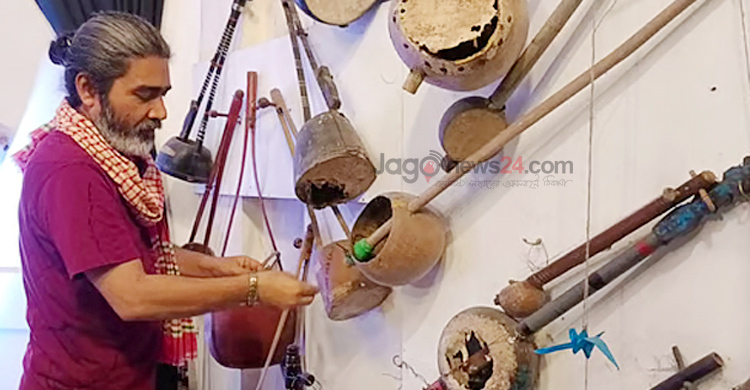One man's mission: Preserving Bangladesh's vanishing musical heritage

In the divisional headquarters of Mymensingh, where the rhythms of modern life pulse to the beat of rock and pop, a quieter melody lingers in the shadows – carried by the fading notes of indigenous musical instruments.
Once the heartbeat of Bangladesh’s cultural heritage, instruments like the ektara, sarinda, and dotara are being drowned out by guitars and keyboards.
But one man, Rezaul Karim Aslam, is fighting to keep their music alive, curating a treasure trove of history in his Asian Music Museum, a sanctuary for the soul of Bangladesh’s musical past.
A collector’s passion born from tradition
Tucked away on Kanchijhuli Road opposite the Anjuman Eidgah ground, Aslam’s museum is no ordinary space. It’s a time capsule, housing over 600 rare and indigenous musical instruments, some dating back to the 17th century.
From the haunting yogi sarangi to the rustic gopijantra (locally known as laua), these relics – many 150 to 350 years old - tell stories of Bauls, monks, and village minstrels. Among the collection are 20 sarindas from the 18th century, 30 sarras, 60 mekuns, and eight distinct sitars, alongside esraj, sarod, tanpura, and more.
Aslam’s journey began in his family’s shop, Nabab & Co., founded in 1944 by his grandfather Nabab Ali in Mymensingh’s Bara Bazar. After his father, Jalal Uddin, took over, a young Aslam found himself drawn to the dusty violins, sitars, and tanpuras stacked in the shop’s corners.
What started as curiosity in 2006 blossomed into an obsession, leading him to scour remote villages for forgotten instruments. “I saw them, I loved them, and I couldn’t let them disappear,” Aslam says, his voice brimming with conviction.
His shop, now a veritable museum itself, overflows with ektantric binas (popularly known as ektara), surbahars, and nakaras, alongside 80 gramophones, 40 radios, and 400 LP record players.
Beyond instruments, Aslam collects cultural artefacts – hookahs, copper pots, and songbooks – that evoke Bangladesh’s bygone eras. “These aren’t just objects,” he explains. “They’re the heartbeat of our heritage, the songs of our ancestors.”
The onslaught of modernity
In a land where Lalon Fakir’s Baul melodies once echoed, the rise of Western music has side-lined traditional sounds. “Indigenous instruments are crying silently under the invasion of rock and pop,” laments Sarwar Jahan, a music enthusiast and presenter. The bamboo flute, once a staple in rural gatherings, has been replaced by keyboards, while the ektara and khanjani are names unknown to many of today’s youth.
Md Abul Munsur, president of Ensemble Theatre, notes that even the tabla, vital to Rabindra and Nazrul music, is rarely used beyond classical circles.
The decline isn’t just cultural, it’s practical. Craftsmen who once handcrafted mridangas or sanais are vanishing, and few new artisans are stepping up.
Md Apel Chowdhury of Chhayanaut in Mymensingh observes, “Boys and girls are drawn to modern instruments. Without active use, our traditional ones risk extinction.”
A museum with a mission
Aslam’s Asian Music Museum, launched in 2020, is a defiant stand against this tide. Housed on the ground floor of a rented building, it showcases instruments like the dhempareng, chong, and thimila, many extinct or on the brink. Aslam doesn’t just collect—he researches and collaborates with modern craftsmen to recreate these instruments, ensuring their legacy endures. “I want the new generation to know their history, to feel the melody of our roots,” he says.
Visitors to the museum encounter a sensory journey: the twang of a 200-year-old sarinda, the deep hum of a tanpura, or the rhythmic clatter of a khanjari. Aslam’s collection also includes ceremonial tools like conches and ghantas, used in rituals, and playful instruments like the domru, once paired with snake charmers. His Jalsaghar collection—featuring vases, candle holders, and hookahs—adds a nostalgic flourish, evoking the opulence of old Bengal.
A call to preserve heritage
The museum has become a beacon for cultural preservation. Mymensingh’s District Cultural Officer, Abdullah Al Mamun, praises Aslam’s efforts: “Through his work, the new generation learns the names and stories of unfamiliar instruments.” He promises support, including potential sponsorship, if Aslam submits a formal proposal to expand the museum.
Aslam, also the founding general secretary of the Mymensingh Baul Shilpi Samity and general secretary of the Bangladesh Sangeet Sangathan Samanway Parishad Divisional Committee, sees his work as a duty. “Musical instrument makers and players are disappearing. I’m saving these treasures for research, for learning, for history,” he says. His dream is to scale up the museum, making it a national hub for cultural education.
A melody worth saving
In a world where digital beats dominate, Aslam’s Asian Music Museum is a reminder that Bangladesh’s soul lies in its melodies—the plaintive wail of a sarengi, the rhythmic pulse of a dhol. As he meticulously restores a 250-year-old sitar, Aslam reflects, “There’s no alternative to our native instruments for true melody. We can’t let them vanish from the eyes of our youth.”
His mission resonates in Mymensingh and beyond, a call to embrace the past while strumming the chords of the future. As pop music blares, Aslam’s quiet rebellion ensures that the songs of Bangladesh’s ancestors will not fade into silence.


